
El Alamein is a town in the northern Matrouh Governorate of Egypt. Located on the Mediterranean Sea, it lies 106 kilometres (66 mi) west of Alexandria and 300 kilometres (186 mi) northwest of Cairo. As of 2007, it had a population of 7,397 inhabitants.
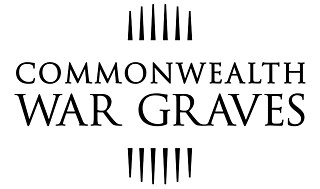
The Commonwealth War Graves Commission (CWGC) is an intergovernmental organisation of six independent member states whose principal function is to mark, record and maintain the graves and places of commemoration of Commonwealth of Nations military service members who died in the two World Wars. The commission is also responsible for commemorating Commonwealth civilians who died as a result of enemy action during the Second World War. The commission was founded by Sir Fabian Ware and constituted through Royal Charter in 1917 as the Imperial War Graves Commission. The change to the present name took place in 1960.
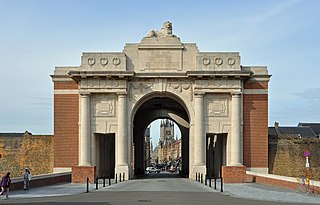
The Menin Gate, officially the Menin Gate Memorial to the Missing, is a war memorial in Ypres, Belgium, dedicated to the British and Commonwealth soldiers who were killed in the Ypres Salient of World War I and whose graves are unknown. The memorial is located at the eastern exit of the town and marks the starting point for one of the main roads that led Allied soldiers to the front line.
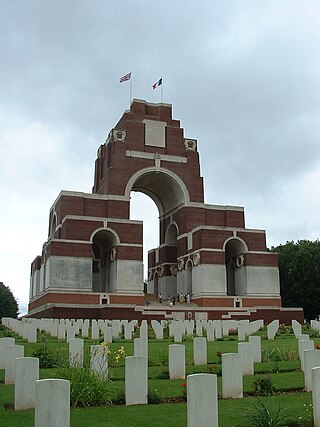
The Thiepval Memorial to the Missing of the Somme is a war memorial to 72,337 missing British and South African servicemen who died in the Battles of the Somme of the First World War between 1915 and 1918, with no known grave. It is near the village of Thiepval, Picardy in France. A visitors' centre opened in 2004. Designed by Sir Edwin Lutyens, Thiepval has been described as "the greatest executed British work of monumental architecture of the twentieth century".

Tyne Cot Commonwealth War Graves Cemetery and Memorial to the Missing is a Commonwealth War Graves Commission (CWGC) burial ground for the dead of the First World War in the Ypres Salient on the Western Front. It is the largest cemetery for Commonwealth forces in the world, for any war. The cemetery and its surrounding memorial are located outside Passendale, near Zonnebeke in Belgium.

Larch Wood Cemetery is a Commonwealth War Graves Commission (CWGC) burial ground for the dead of the First World War located in the Ypres Salient on the Western Front in Belgium.
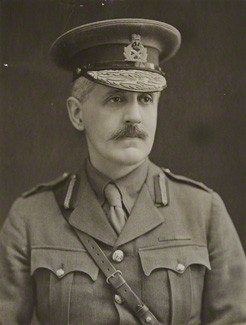
Major-General Sir Fabian Arthur Goulstone Ware was a British educator, journalist, and the founder of the Imperial War Graves Commission (IWGC), now the Commonwealth War Graves Commission (CWGC). He also served as Director of Education for the Transvaal Colony and editor of The Morning Post.

Chester Farm is a Commonwealth War Graves Commission burial ground for the dead of the First World War located in the Ypres Salient on the Western Front.

The Loos Memorial is a World War I memorial forming the sides and rear of Dud Corner Cemetery, located near the commune of Loos-en-Gohelle, in the Pas-de-Calais département of France. The memorial lists 20,610 names of British and Commonwealth soldiers with no known grave who were killed in the area during and after the Battle of Loos, which started on 25 September 1915. This memorial covers the same sector of the front as the Le Touret Memorial, with each memorial commemorating the dead either side of the date of the start of the Battle of Loos.
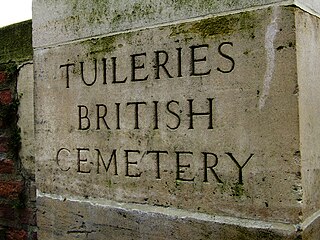
Tuileries British Cemetery is a Commonwealth War Graves Commission burial ground for the dead of the First World War located near Ypres (Ieper) in Belgium on the Western Front.

Hedge Row Trench Cemetery is a Commonwealth War Graves Commission burial ground for the dead of the First World War located near The Bluff south of Ypres (Ieper) in Belgium on the Western Front.
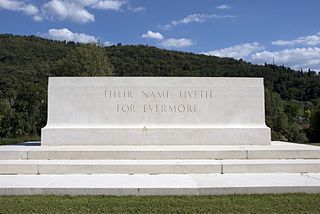
The Stone of Remembrance is a standardised design for war memorials that was designed in 1917 by the British architect Sir Edwin Lutyens for the Imperial War Graves Commission (IWGC). It was designed to commemorate the dead of World War I, to be used in IWGC war cemeteries containing 1,000 or more graves, or at memorial sites commemorating more than 1,000 war dead. Hundreds were erected following World War I, and it has since been used in cemeteries containing the Commonwealth dead of World War II as well. It is intended to commemorate those "of all faiths and none", and has been described as one of Lutyens' "most important and powerful works", with a "brooding, sentinel-like presence wherever used".
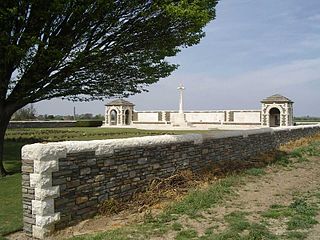
The V.C. Corner Australian Cemetery and Memorial is a Commonwealth War Graves Commission World War I cemetery and memorial. The site is located in the commune of Fromelles, in the Nord departement of France, about 2 kilometres (1.2 mi) northwest of the village of Fromelles on the D22C road (rue Delval).

Founded in 1917, the Ramscappelle Road Military Cemetery is located two kilometers east of the city of Nieuwpoort in the province of West Flanders (West-Vlaanderen), Belgium. It is on the N367, the road which leads from Nieuwpoort to the village of Sint-Joris, near the intersection with Ramscappelle Road (Ramskapellestraat).

John Kipling was the only son of British author Rudyard Kipling. In the First World War, his father used his influence to get him a commission in the British Army despite being decisively rejected for poor eyesight. His death at the Battle of Loos caused his family immense grief.

Between 1923 and 1936, the Imperial War Graves Commission erected a series of memorial tablets in French and Belgian cathedrals to commemorate the British Empire dead of the First World War. The tablets were erected in towns in which British Army or Empire troops had been quartered.

"Their name liveth for evermore" is a phrase from the King James Version of the Bible, forming the second half of a line in Ecclesiasticus or Sirach, chapter 44, verse 14, widely inscribed on war memorials since the First World War.






















